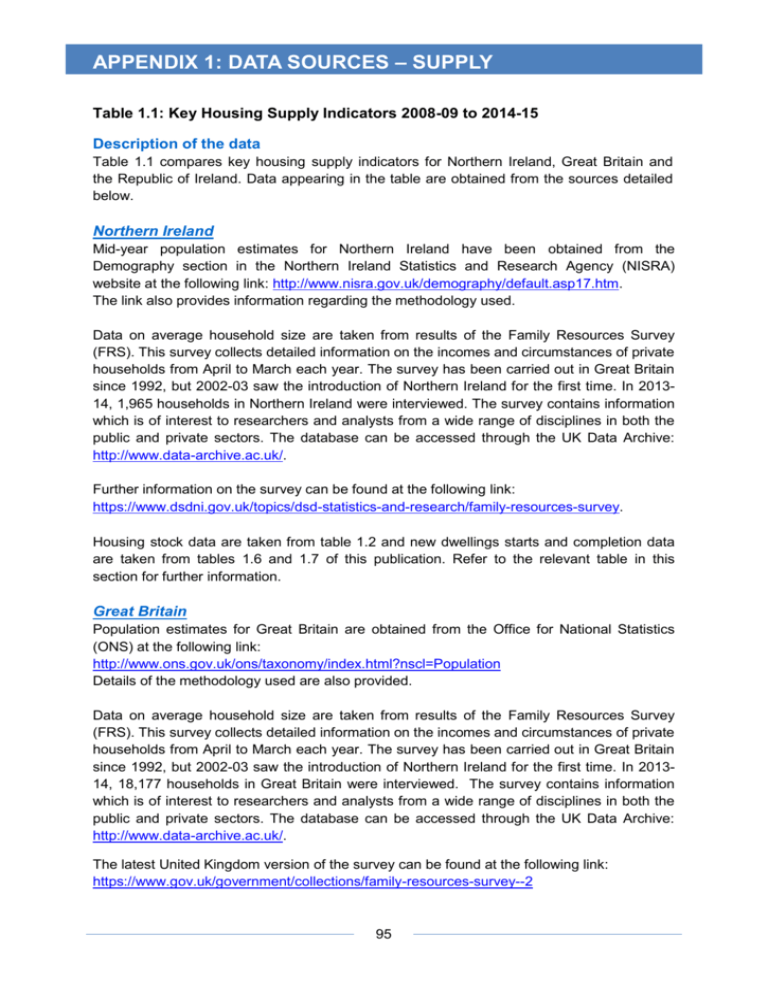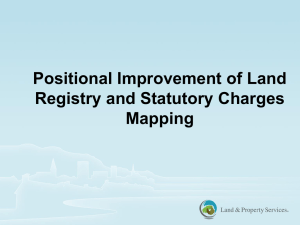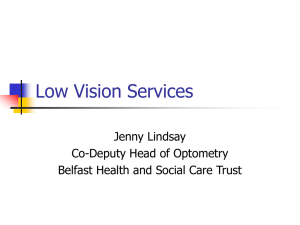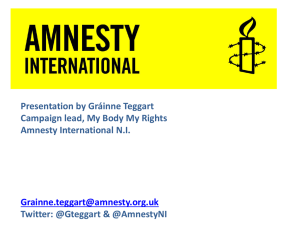Northern Ireland Housing Statistics 2014-15
advertisement

APPENDIX 1: DATA SOURCES – SUPPLY Table 1.1: Key Housing Supply Indicators 2008-09 to 2014-15 Description of the data Table 1.1 compares key housing supply indicators for Northern Ireland, Great Britain and the Republic of Ireland. Data appearing in the table are obtained from the sources detailed below. Northern Ireland Mid-year population estimates for Northern Ireland have been obtained from the Demography section in the Northern Ireland Statistics and Research Agency (NISRA) website at the following link: http://www.nisra.gov.uk/demography/default.asp17.htm. The link also provides information regarding the methodology used. Data on average household size are taken from results of the Family Resources Survey (FRS). This survey collects detailed information on the incomes and circumstances of private households from April to March each year. The survey has been carried out in Great Britain since 1992, but 2002-03 saw the introduction of Northern Ireland for the first time. In 201314, 1,965 households in Northern Ireland were interviewed. The survey contains information which is of interest to researchers and analysts from a wide range of disciplines in both the public and private sectors. The database can be accessed through the UK Data Archive: http://www.data-archive.ac.uk/. Further information on the survey can be found at the following link: https://www.dsdni.gov.uk/topics/dsd-statistics-and-research/family-resources-survey. Housing stock data are taken from table 1.2 and new dwellings starts and completion data are taken from tables 1.6 and 1.7 of this publication. Refer to the relevant table in this section for further information. Great Britain Population estimates for Great Britain are obtained from the Office for National Statistics (ONS) at the following link: http://www.ons.gov.uk/ons/taxonomy/index.html?nscl=Population Details of the methodology used are also provided. Data on average household size are taken from results of the Family Resources Survey (FRS). This survey collects detailed information on the incomes and circumstances of private households from April to March each year. The survey has been carried out in Great Britain since 1992, but 2002-03 saw the introduction of Northern Ireland for the first time. In 201314, 18,177 households in Great Britain were interviewed. The survey contains information which is of interest to researchers and analysts from a wide range of disciplines in both the public and private sectors. The database can be accessed through the UK Data Archive: http://www.data-archive.ac.uk/. The latest United Kingdom version of the survey can be found at the following link: https://www.gov.uk/government/collections/family-resources-survey--2 95 APPENDIX 1: DATA SOURCES – SUPPLY The Department for Communities and Local Government (DCLG) make housing stock and house building statistics available through the “gov.uk” website. Housing stock statistics for Great Britain are obtained from table 102 at the following link: https://www.gov.uk/government/statistical-data-sets/live-tables-on-dwelling-stock-includingvacants. Details of relevant notes and definitions can be located at the following link: https://www.gov.uk/government/organisations/department-for-communities-and-localgovernment/series/dwelling-stock-including-vacants. House building statistics for Great Britain are obtained from tables 208 and 209 at the following link: https://www.gov.uk/government/statistical-data-sets/live-tables-on-house-building. Details of relevant notes and definitions are also provided at the above link. Republic of Ireland Republic of Ireland population estimates are obtained from the Central Statistics Office Ireland (CSO) via “Stats Bank” (their main dissemination service) at the following link: http://www.cso.ie/px/pxeirestat/Statire/SelectVarVal/Define.asp?maintable=PEA07&PLangu age=0 . Further information and details of the methodology used are available within the Population and Migration Estimates April 2014 report at the following link: http://www.cso.ie/en/releasesandpublications/population/. Housing stock statistics for the Republic of Ireland are obtained from the Department of the Environment, Community and Local Government at the following link- Latest House Building and Private Rented Statistics (under Housing Stock): http://www.environ.ie/en/Publications/StatisticsandRegularPublications/HousingStatistics/. New dwelling completion statistics for the Republic of Ireland are obtained from the Department of the Environment, Community and Local Government at the following link: http://www.cso.ie/px/pxeirestat/statire/SelectVarVal/Define.asp?MainTable=HSM01&TabStri p=Select&PLanguage=0&FF=1 New dwelling starts statistics for the Republic of Ireland are obtained from the Department of the Environment, Community and Local Government at the following link- Latest House Building and Private Rented Statistics (under Commencement Notices): http://www.environ.ie/en/Publications/StatisticsandRegularPublications/HousingStatistics/. 96 APPENDIX 1: DATA SOURCES – SUPPLY Table 1.2: Total Housing Stock in each of the 11 District Council Areas 20082015 Table 1.4: Number of Dwellings by Type in each of the 11 District Councils of Northern Ireland – April 2015 Tables 1.2 and 1.4 provide information on Housing Stock in Northern Ireland which is published by Land and Property Services at the following link: https://www.dfpni.gov.uk/topics/statistics-and-research-0. Data Quality Relevance Land & Property Services maintains Valuation Lists for all Domestic and Non-Domestic properties in Northern Ireland for the purposes of rating. The housing stock figures show the number of domestic dwellings which have a rates liability. Data is produced at Northern Ireland level and for each local Government District within Northern Ireland. In line with the Rates Order (NI) 1977, Housing Stock is defined as a count of properties which are valued as domestic or mixed for the purposes of rating. This refers to properties in the Valuation List which are used (or when next in use, will be used) for the purposes of a private dwelling. This includes properties which are temporary incapable of beneficial occupation, but excludes Caravans, Domestic Garages, Domestic Stores and Car Parking Spaces. There are a variety of users of the data – government, economic analysts, the media, academics and the general public. Within government Housing Stock data may be used in policy formation, evaluation and in response to Assembly Questions. Accuracy Housing Stock data is sourced from the NI Domestic Valuation List. The Valuation List is as close as possible to a census of all properties in Northern Ireland, therefore there is no sampling error associated with the data. The Valuation List information is held in an administrative IT system named Assessment Office (AO). This is a live system and LPS Statistics Branch takes snapshots of the information at a point in time. The quality of the data is very good as it is generated directly from the official record of the Valuation List. Processing errors: Processing errors happen when mistakes occur in the implementation of the administrative and statistical methods used to produce the results. Revisions as a result of human error are identified as such in the revisions section of the published LPS statistics report. Measurement errors: Property characteristic fields may hold erroneous values in AO. LPS Statistics Branch has developed a range of error checks to identify erroneous values and these are highlighted with Valuation staff and corrected on AO. 97 APPENDIX 1: DATA SOURCES – SUPPLY Provision of revised data: LPS Statistics Branch checks all data that are to be published carefully in order to provide a high level of quality assurance in relation to the data. Nonetheless, as the figures are extracted from a live system on a particular date, figures may change due to ongoing validation checks and changes by the system administrators. Dates on the LPS web page let the users know when the data was last updated/revised. Timeliness and Punctuality Housing Stock figures are published annually in June to show the position at the beginning of April each year. Data downloads from the Domestic Valuation List were created for the first time in 2007-08. Some historic figures could only be produced to show the position at the beginning of May of the particular year. This is clearly stated in the title of the published LPS affected tables. All data so far have been released on the planned publication date. In the unlikely event of a change to the planned release of data in June, a note giving the reason for the change would be placed on the website as soon as possible along with the expected new release date, as set out in the Code of Practice for Official Statistics Accessibility and Clarity The Housing Stock data is provided in excel format via the Department of Finance and Personnel website and is available for download https://www.dfpni.gov.uk/topics/statisticsand-research-0. The document contains tables and text to conform to the Code of Practice for Official Statistics. There is a Notes section which contains definitions and limitations of the data and details of the revisions policy. Coherence and Comparability There are two sources of housing stock data in Northern Ireland: Land & Property Services Valuation List and the Northern Ireland Housing Executive House Condition Survey. There are differences in the data published from each source as there are differences in the data collection methods and methodology used. Therefore the LPS Housing Stock figures are not directly comparable with the NIHE House Condition Survey dwelling stock estimates. For completeness the NIHE House Condition Survey is available http://www.nihe.gov.uk/index/corporate/housing_research/house_condition_survey.htm at Housing Stock information is available for Northern Ireland and each of the Local Government Districts within NI on a comparable basis from 2008 - 2015. Trade-offs between Output Quality Components The main users want the figures to be available as soon as possible after the period to which they refer. Estimates are published as soon as validation is finished and quality assurance is completed. As a result, revisions are an inevitable consequence of the trade-off between timeliness and accuracy. 98 APPENDIX 1: DATA SOURCES – SUPPLY Assessment of User Needs and Perceptions Housing Stock data was first published by LPS in June 2015 and known users of LPS housing statistics were informed of the new statistical series by email. LPS Statistics Branch welcomes feedback from all users and users can contact the responsible statistician Ciara Cunningham, either by phone on 028 90 336035 or by e-mail at LPS.StatisticsBranch@dfpni.gov.uk The contact details are provided on the LPS website and in the published LPS Housing Stock document. Performance, Cost and Respondent Burden The process of producing the housing stock statistics is carried out in-house and is a byproduct of other statistical analysis. The data used are collected for a different official purpose and therefore there are no data collection costs attributable to the housing stock figures. Confidentiality Transparency and Security The data are held on a network that is accredited to the security level of the data and is accessible only to LPS staff involved in the production process. During the publication process all hard copies of interim results are locked away or securely disposed of. LPS staff are trained and reminded of the protocols for ensuring the data remain confidential. This covers physical security, IT security and data disclosure issues. Table 1.3: Household Tenure 2008-09 to 2014-15 Description of data The information contained in table 1.3 is derived from the Northern Ireland Continuous Household Survey. The Continuous Household Survey (CHS) is one of the largest continuous surveys carried out in Northern Ireland. The survey is designed, conducted and analysed by the Central Survey Unit (CSU) of the Northern Ireland Statistics and Research Agency (NISRA). It is based on a sample of the general population resident in private households and has been running since 1983. The survey is designed to provide a regular source of information on a wide range of social and economic issues relevant to Northern Ireland. The sample for table 1.3 contained 2,521 households. Data Quality Relevance Each year CSU sets the content of the questionnaire in consultation with client departments. The questionnaire consists of both a household interview and an individual interview with each person aged 16 and over. Both the household and individual questionnaires consist of core items that are included each year, modules that recur on a regular cycle and ad hoc modules. Core items include accommodation, tenure, employment status, employment activity, educational qualifications, adult health and family information. Non-core items include attitudes to environmental issues, prevalence of overnight and day trips, prevalence of smoking and sports and leisure activities. 99 APPENDIX 1: DATA SOURCES – SUPPLY Accessibility and Clarity Information from the CHS is published on the CSU website: http://www.csu.nisra.gov.uk/CHS/CHS.htm. A bespoke information request service is available to all users of CHS. CHS data is deposited annually in the UK Data Archive and is available to any user wishing to carry out individual analysis. Accuracy Coverage Errors - There are no major coverage issues. The CHS sample is drawn from the Pointer Database which contains address information for every property in NI. People living in institutions are excluded. Proportion of Missing Values - Missing values or item non-response to the data contained in table 1.3 is negligible. Information on data processing - Data is collected by personal interview using CAPI (Blaise), and the interviews are spread equally over the 12 months from April to March. Data is returned from the field via FTP dial up. Data is downloaded onto secure network drives and processed through the CHS data management system. Data is coded by trained administrative staff. The data is fully validated by CSU statistical staff. Information on quality control and quality assurance - The CHS uses the ONS Primary and Secondary Harmonised questions as far as possible and where appropriate. Questions are pre-tested before they go into field. The CAPI questionnaire is scripted in Blaise which allows CSU staff to define range and consistency checks for each question and to control routing throughout the questionnaire. The data is subject to further validation checks including treatment of outliers and detailed consistency checking including non-credible checks. A 10% check of all coded data is undertaken by statistical staff to ensure that coding procedures are of a high standard. All completed CHS interviews are back-checked with respondents to ensure that interviews are valid. Interviewers undergo intensive induction training and are trained (face-to-face) before working on CHS. The quality of data returned by interviewers is assessed and is scored as part of their performance management. Sample Design and Sampling Frame - The CHS is based on a systematic random sample of 4,500 addresses drawn each year from the Pointer Database. Pointer is the address database for Northern Ireland and is maintained by Land & Property Services (LPS), with input from Local Councils and Royal Mail (RM). This is now the common standard address for every property in Northern Ireland. The addresses on the Pointer Database are sorted by district council and ward, so the sample is effectively stratified geographically. A starting point in the sampling frame is randomly selected and then every nth (fixed interval) is selected by counting through the frame. Response Rate - The target response rate on CHS is 68%. That is, obtaining interviews at 68% of eligible addresses. Addresses which are vacant, derelict etc and which do not contain people are deemed to be ineligible. The response rate achieved on the 2014/15 CHS was 65%. Non Response Error/Bias - Non-response bias on CHS is measured by comparing the characteristics of the achieved sample with the distribution of the same characteristics in the sampling frame or Census. Typically, CHS data is unweighted although some clients choose to apply weights to the data because of the nature of the topic under analysis. The data contained in table 1.3 is unweighted. Proxy responses - on CHS, there are no proxy interviews. The household schedule, from 100 APPENDIX 1: DATA SOURCES – SUPPLY which the data in table 1.3 is collected, is answered by the Household Reference Person (HRP) or spouse on behalf of the whole household. Imputation rates - no imputation of data occurs on CHS. Sampling Error - Because CHS data is based on a sample rather than the whole populations it is subject to sampling error. Sampling error is the difference between the estimate derived from a sample and the 'true' value that would result if a census of the whole population were taken under the same conditions. Timeliness The CHS runs on a financial year cycle (Apr-Mar) and the data is updated three months after the close of the data collection cycle. The latest CHS results, based on CHS 2014-15 became available in July 2015. Coherence and Comparability CHS data has been collected annually since 1983 and this data can be compared over time. Table 1.5: Unfitness and Basic Amenities 1991 to 2011 Data Quality Relevance Table 1.5 reports on House Condition Survey data. This survey of housing stock is carried out by the Housing Executive across all tenures and house types; for example, owner occupied and rented housing, vacant dwellings, houses in multiple occupation. It is the most comprehensive source of information on housing stock in Northern Ireland. Users of the tables are those with an interest in the housing sector; including government officials, the voluntary sector, charities, the private sector and others. Accessibility and Clarity The tables are published in the DSD’s annual Housing Statistics, where it is available in pdf, Excel and Word format. Requests for the information in different formats can be made by contacting the Department for Social Development. The House Condition Survey 2011 report and accompanying statistical annex are available to download as pdf documents from the Housing Executive web site: (http://www.nihe.gov.uk/index/corporate/housing_research/house_condition_survey.htm). Accuracy The House Condition Survey (HCS) is a sample survey. Due to budgetary pressures the 2011 sample was reduced to approximately 2,000 (3,000 in 2009). The sampling method chosen was one considered to permit a better matching with the 2011 Census for the purpose of District Council Area regression modelling and was completed in two stages. The first stage was a random sample of 1,000 properties across Northern Ireland. This was checked for distribution and was considered to be a reasonable representation of District Council areas. 101 APPENDIX 1: DATA SOURCES – SUPPLY The second stage was a further random sample of 1,030 properties selected by District Council Area to ensure that each district total added to 70. In Belfast District Council Area, a total of 280 households were selected (70 in North, East, South and West Belfast). The sample frame in 2011 was the survey sampling database held at the Northern Ireland Statistics and Research Agency (NISRA). This database contained a subset of the computerised records for domestic residential property maintained by Land & Property Services. The gross response rate was 71%. The 2011 figures on unfitness and basic amenities published in this table are considered robust at Northern Ireland level. Regression modelling provides reasonably robust District Council Area figures (available from July 2014). As part of the 2011 survey, data was quality assured at a number of different stages in the process. The 2011 survey used mobile field computers (Motion 5 Field Tools) which enabled surveyors to complete more complex self-validation of their forms at the time of the survey. This included highlighting any missing data or inconsistencies between sections of the form. The direct keying of data onto a mobile computer in the field also improved data quality by reducing the punching errors that are can be associated with the later transfer of information from paper based formats to electronic formats. Surveyors completed further quality assurance checks after forms were uploaded, using an enhanced validation programme. Each form was then checked by supervisors, who were responsible for checking key technical data and completing and correcting (as appropriate) in consultation with the surveyor. Further post-validation checks and analysis by the Housing Executive Research Unit indicated that, following validation, data quality was high. Key statistics were similar to those emerging from other Northern Ireland surveys. Timeliness Field work for the most recent House Condition Survey was carried out between May and September 2011. Preliminary key findings were published on the Housing Executive web site in May 2012; this was followed by the main set of Northern Ireland-level tables in early November 2012. Modelled District Council level figures for key government measures (Fuel Poverty, Decent Homes and Unfitness) were published July 2014. Coherence and Comparability House Condition Surveys have assessed dwelling conditions against the Statutory Fitness Standard since 1974. The current Fitness standard is set out in Schedule 5 of the Housing (Northern Ireland) Order 1992, which states that a dwelling is unfit for human habitation if it fails to meet one or more of the following requirements: It is structurally stable. It is free from serious disrepair. It is free from dampness prejudicial to the health of the occupants (if any). It has adequate provision for heating, lighting and ventilation. It has an adequate supply of wholesome water. There are satisfactory facilities in the house for the preparation and cooking of food, including a sink with a satisfactory supply of hot and cold water. 102 APPENDIX 1: DATA SOURCES – SUPPLY It has a suitably located water closet for the exclusive use of the occupants (if any). It has, for the exclusive use of the occupants (if any), a suitably located fixed bath or shower and wash-hand basin, each of which is provided with a satisfactory supply of hot and cold water. It has an effective system for the draining of foul, waste and surface water. In addition, flats may be classified as unfit if the building, or part of the building outside of the flats, fails to meet any of the following requirements and, by reason of that failure, is not suitable for occupation. The building or part is structurally stable. It is free from serious disrepair. It is free from dampness. It has adequate provision for ventilation. It has an effective system for the draining of foul, surface and waste water. The current fitness standard came into effect in Northern Ireland on 1st October 1992, and the rate of unfitness has been assessed using these criteria since (and including) the 1991 House Condition Survey. Where provision of basic amenities is concerned, published data have been based on the same method of assessment for each year reported in the table. Table 1.6: Building Control New Dwelling Starts by Development Type 20102015 Table 1.7: Building Control New Dwelling Completions by Development Type 2010-2015 Description of the data Tables 1.6 and 1.7 provide information relating to Building Control new dwelling starts and completions published by Land and Property Services (LPS). Building Control Starts and Completions Land & Property Services (LPS) receives information from Building Control in each council in Northern Ireland. This information contains the number of recorded new domestic dwellings started and completed. Each office extracts information from the applications for building approval. This information is then validated and input into a building control database provided by either Tascomi or Northgate. A reporting tool is then used to interrogate the database and extract the relevant information. For further details see: http://www.buildingcontrol-ni.com/. The date of a new dwelling start is the date on which the first building control inspection takes place. The date of a new dwelling completion is the date on which the building control completion inspection takes place. Building control defines a property as complete when, further to final inspection being 103 APPENDIX 1: DATA SOURCES – SUPPLY carried out, as far as can be ascertained, the property is in compliance with NI Building Regulations and a certificate is issued. Data Quality Relevance Information on building control new dwellings starts and completions, covering the whole of Northern Ireland, are of interest to anyone with an interest in the housing market. The data are used by government policy makers, economic commentators, business organisations, academics and others. Accessibility and clarity LPS now publish new dwelling starts and completions on a quarterly basis, including breakdowns by the 11 District Councils. Further information is available on their website: https://www.dfpni.gov.uk/topics/statistics-and-research/new-dwelling-statistics. Building control starts and completions data are available quarterly within the Northern Ireland Housing Bulletin and annually within the Northern Ireland Housing Statistics publication. Relevant footnotes are included with each table, as necessary, and the published data are available in electronic format on DSD’s website. Accuracy The statistics cover the whole of Northern Ireland. The only measurable source of error arises from data inputting. Missing values are not an issue. Quality control and validation is carried out by the building control office before sending to LPS. This includes validation of key fields (e.g. purpose group) and other internal consistency checks (e.g. that the description of works aligns with fees and costs of works). When the data are received by LPS additional checks are carried out on the data (e.g. that Purpose Groups and dates are correct). Figures are revised on an annual basis to capture Building Control applications received outside of the quarter. Timeliness Building control starts and completions data are received from councils, collated by LPS, and published quarterly in February, May, August and November. Coherence and Comparability Building Control Offices are the sole source of information on private sector new dwelling starts and completions. All 11 District Councils make returns; therefore there is complete coverage of Northern Ireland. Building Control starts and completions data published by LPS from March 2015 onwards differ from those previously published by DSD due to quality improvements made by LPS which have addressed historical difficulties with regard to late returns by councils and duplicate records. ASU previously adjusted the private sector completions on receipt of the data due to the perceived under recording of completions data. The adjustment resulted in private sector completions being increased by a factor of 1.32 which was based on the best information available at that time. A review of DSD reporting of starts and completions data in 2014 and 104 APPENDIX 1: DATA SOURCES – SUPPLY 2015, concluded that this adjustment was no longer required, due to improvement over the years in terms of data quality as well as the availability of a longer time series where completions eventually make their way into the series. Table 1.8: Social Housing Development Programme (SHDP) New Social Housing Dwelling Starts 2010-11 to 2014-15 Table 1.9: Social Housing Development Programme (SHDP) New Social Housing Dwelling Completions 2010-11 to 2014-15 Data Quality Data Source and Validation The Northern Ireland Housing Executive (NIHE) manages the delivery of the Social Housing Development Programme and maintains a database which records all information relating to social rented sector starts and completions. Data is populated on the database, in part, based on paper returns received from all Housing Associations. Prior to input onto the system the returns are checked and verified. Downloads from the database are also validated to ensure consistency over time and reliability of results. The majority of social housing starts are confirmed in the final quarter of the programme year (i.e. January to March), as it often takes 6-9 months to secure Planning Permission for a new housing scheme. For accuracy, a social sector start on-site or completion is only confirmed when appropriate levels of paperwork are received from housing associations. In the case of social sector new build starts on-site, this will include: A solicitor’s letter confirming that the site is in the ownership of the housing association; Proof of Planning Permission; An extract of the Works Contract confirming contractor’s date of possession of the site. This differs from Building Control Starts and Completions which are recorded as the date of first and last building control inspection. Accessibility/Timeliness Annual social housing starts and completions data are available within DSD’s quarterly Northern Ireland Housing Bulletin and annually within the Northern Ireland Housing Statistics publication. The Northern Ireland Housing Executive publishes a three year Social Housing Development Programme at the following link: http://www.nihe.gov.uk/index/services/housing_need.htm. Historical information is available indicating where social housing has been provided over the last 5 years. 105 APPENDIX 1: DATA SOURCES – SUPPLY In addition, the Housing Executive publishes annual Housing Investment Plans for each of the 11 new District Council areas. Housing Investment Plans describe Housing Executive strategies within the respective District Council areas and in particular provide details of Housing Executive performance over the past year and the programmes planned for the following year. Housing Investment Plans are published on the Housing Executive’s website at the following link: http://www.nihe.gov.uk/index/corporate/plans/district_housing_plans.htm. Coherence & Comparability The time series of social housing starts and completions data in this report are coherent and are directly comparable over time. Links to other parts of UK Starts and completions data from other parts of the UK can be accessed using the following link: http://www.communities.gov.uk/housing/housingresearch/housingstatistics/housingstatisticsb y/housebuilding/livetables/ Table 1.10: Chained Volume Measure of Housing Output in Northern Ireland 2005 to 2015 Table 1.11a: Volume of Output in Northern Ireland by Construction Sector 2005 to 2015 (Current Prices) Table 1.11b: Volume of Output in Northern Ireland by Construction Sector 2005 to 2015 (Chained Volume Measure Prices and Seasonally Adjusted) Description of the data Tables 1.10, 1.11a and 1.11b contain Construction Output Statistics published in the Northern Ireland Construction Bulletin (a National Statistics publication) which are intended to provide a general measure of quarterly changes in the volume and value of construction output in Northern Ireland. These figures are derived from the Northern Ireland Quarterly Construction Enquiry (QCE). This is a statutory survey of construction firms operating in Northern Ireland. Each quarter a sample of construction firms are asked to provide details of the value of construction activity they have undertaken in a specified period (relating to work carried out in Northern Ireland only). The survey also includes public sector organisations which carry out their own construction activity. For further information including details on quality refer to the following link: https://www.detini.gov.uk/articles/construction-output-statistics. 106 APPENDIX 1: DATA SOURCES – SUPPLY Table 1.12: Residential Planning Applications and Decisions 2003-04 to 201415 Table 1.13: Residential Planning Decisions by Classification 2013-14 and 201415 Table 1.14: Residential Planning Applications and Decisions by Planning Division and Local Government District 2014-15 Table 1.15: Residential Planning Decisions by Sub-classification and Planning Division 2014-15 Tables 1.12 to 1.15 give detail on residential planning applications and decisions. Relevance Data is provided at Northern Ireland Planning Division and Local Government District level. Other geographies (such as Assembly Areas) are available on request from Planning. Accessibility and Clarity All applications received in the year may not have had a decision issued within the same time period and applications decided in the year may not have been received in the same time period. Accuracy The accuracy of the data is very good. A number of validation and Quality Assurance processes take place. Planners are contacted if there are any queries. Timeliness DOE publishes an annual statistical bulletin each summer: http://www.doeni.gov.uk/index/information/asb/statistics/planning_statistics.htm Coherence and Comparability The annual publications up to 2010-11 were similar in structure and content so comparisons over time were possible up to and including that publication. As of the 2011-12 report, only Residential Planning Applications and Decisions have been included, whereas all Planning Applications and Decisions were shown in previous years. This means that figures published in Northern Ireland Housing Statistics from 2011-12 are not comparable with those published in previous years. Residential properties include housing developments (incorporating a mixture of house types and apartments), purpose built apartment developments, sheltered housing schemes, single dwellings including dwellings on farms, holiday chalets, caravans and mobile homes, alteration, extension or improvement of existing dwellings, residential homes or nursing homes, hotels or motels. In 2014-15 there was a change to the structure of planning area offices which is reflected in the tables provided. Please note that from April 2015 responsibility for provision of the 107 APPENDIX 1: DATA SOURCES – SUPPLY planning function has transferred to Local Government, although this will not affect these figures for 2014-15. For further information refer to the annual bulletin at the link below for user guidance/notes on data: http://www.doeni.gov.uk/index/information/asb/statistics/planning_statistics.htm. 108









